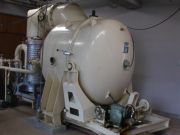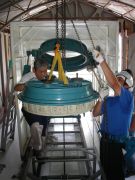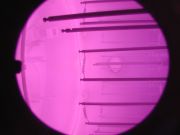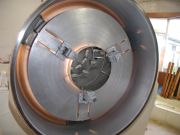|
|
In order to keep high refrectivity, flatness of the surface, we
perform maintenance for the mirrors during the rainy season. This is
because the low refrectivity, and the bad surface conditions will
cause significant scattering during the observation.
The maintenance can be roughly surmarized as 1) to remove the old
metal-coating of the mirror, and 2) to newly plate the mirror with
Alminuum. We use a device called "Vacuum Evaporater" (VE) which we
have in Hida observatory, to plate Al to the glass.
|

The "Vacuum Evaporater" (VE) in the Hida Observatory. By forming a
vacuum inside the VE, we plate the glass which is placed at the center
of the image with Al. We can plate mirrors as large as 100cm of
diameter with this VE.
|

The removal of the mirrors from the 70cm Celostat telescope in Kwasan
Observatory. Mr.Ishiura, and Mr.Kimura are working carefully not to
damage the mirrors nor the telescope.
|
We have performed the maintenance of the mirrors of the 70cm Celostat
telescopein Kwasan, and the 60cm refractor in Hida this year (from
June to July). The mirrors in Kwasan are sent to Hida, and then are
proceeded with the following procedures.
- Removal of the old Al-coating.
- To wash the surface of the glass.
- To plate new Al.
|
|
Removal of the old Al coating
|
|
The old Al coating is removed by solution of sodium-hydroxide.
|
|
To wash the surface
|
|
After the removal of the old plate, we wash the glass (which became
transparent) with the solution of ethanol and ether to remove not only
dust but also oil. After this, we put the glass until it gets dry.
After the glass become dry, we put it inside the VE, and form a
vacuum. Then we discharge to create plasma of oxigen inside the
VE. The surface of the glass is then irradiated by the plasma, and it
becomes highly clean, and activated. The activation of the surface
enhances the efficiency of the plating Al to the glass surface. This
procedure is called "Ion-bombered".
|

A snap shot of inside the VE during the "Ion-bombered". The medium inside
the VE radiates pink light due to the discharge. The few filamentary
things which look like springs are the filmanets of tungsten with Al.
|
|
Plating Al.
|

The newly plated mirrors. Looks good, and is ready for the summer
season which is suitable for observation.
|
This is the main procedure. After forming higher vacuum (about
1/70,000,000 of the air pressure), we heat the filament of tungsten up
to 1600 degrees of Celsius with the electric current to vaporise the
Al, and plate the surface of the glass. Then the operator stops the
electric current to cease heating the tungsten and vaporising the Al
to adjust the thickness of the Al plate, by looking at the lamp
backside of the mirror which gradually becomes darker by the
Al-coating being plated on the glass surface. (Please click here to watch inside the VE during the plating.)
|
|
This procedure of plating the Al lasts only about 10 seconds. If the
thickess of the Al coating is too thin or too thick, we have to do
everything again, so that this procedure requires the operator with a
high skill based on many years of experience.
Actually there are much more processes which are not described
here. For example, the "Anneal" procedure in which we fuse the Al into
the tungsten, or to heat the tungsten-filaments in advance to the main
heating to vaporise the Al are the procedures which were resulted by
the trials and errors of our pioneers.
|
|

